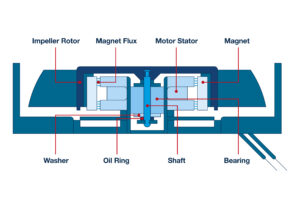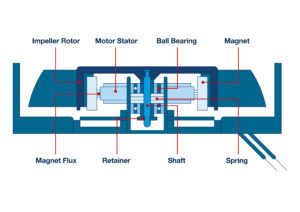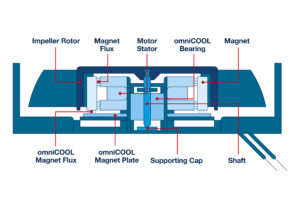Jeff Schnabel, President at CUI Devices and Simon Duggleby, Supplier Marketing Manager, EMEA at Mouser Electronics
The humble cooling fan is, by its nature, one of the unsung workhorses of modern industry. Often hidden away inside subsystems and components, these near-silent devices work tirelessly in the background, ventilating heated air out of machine environments to enable them to work optimally.
Typically, cooling fans have been used for heat management of PCs and telecoms/data center servers. However, as industrial megatrends such as digitalisation and electrification gather pace, they are finding a broader range of applications in areas such as IoT devices, advanced driver assistance systems, and other electronic components onboard modern connected vehicles.
Indeed, according to a recent report, the global cooling fan market is set to expand rapidly, rising from $8,257 million in 2019 to an estimated $10,540 million by 2024, representing a compound annual growth rate of 5 percent. That means a considerable opportunity for fan manufacturers, who are increasingly looking at improving the efficiency of their devices to secure market share.
In terms of their operation, cooling fans are elegant in their simplicity, making them both reliable and cost-effective. A typical design comprises an electric motor that has a set of blades attached to move the air as efficiently and effectively as possible. They can rotate thousands of times per minute, adding up to millions of rotations per day, and can last for years. However to perform is the type of bearing used to mount the blades to the motor, with the quality of the bearing defining the quality of the fan. Multiple types of bearings are available, with sleeve and ball types used most frequently. However, both bearing types come with their advantages and disadvantages, which means that the fan manufacturers are always on the lookout for new bearing solutions that can improve the performance of their products.
“Sleeve and ball bearings account for the vast majority of the market when it comes to fan applications, and they are well-proven components,” says Simon Duggleby, Supplier Marketing Manager, EMEA at Mouser Electronics. “Sleeve-bearing-based fans are used extensively, especially in static equipment that operates at normal ambient temperatures. They are particularly popular in computer and office equipment as well as industrial cabinets and HVAC equipment. Ball-bearing fans, meanwhile, are a popular alternate to sleeve-bearing designs offering benefits in certain circumstances and the ability to operate at elevated temperatures. However, both types have their deficiencies, and other solutions are emerging.”
Sleeve Bearings: reliable and flexible
So, let us look at each bearing solution, in turn, assessing their pros and cons? A typical sleeve-bearing design comes with a central shaft enclosed in a metal sleeve filled with a lubricant to reduce wear and facilitate easy rotation. The sleeve protects the shaft and ensures positional integrity, maintaining the all-important gap between the rotor and stator.
 Figure 1: Typical cross-section of a sleeve bearing.
Figure 1: Typical cross-section of a sleeve bearing.
Setting the gap between the shaft and the sleeve is a crucial consideration. If the space is too small, then friction will increase, requiring more power than necessary and impacting overall system efficiency. If the gap is larger than necessary, then the rotor and the fan blades will wobble.
As the rotor relies on the sleeve to secure its position, eventually the bore of the bearing will get worn down due to the billions of rotations of the fan during its lifetime. This problem is made worse as the rotation direction is always the same. Eventually, the cylindrical hole will become oval in shape, reducing the lifetime of the fan and increasing operating noise levels.
Moving or re-orienting the fan will cause wear to occur in multiple places. This leads to uneven bearing wear that also causes the fan blades to wobble and noise levels to increase, often to an unacceptable level.
Sleeve bearings are self-lubricating, but this requires oil rings and Mylar washers (as shown in Figure 1) to retain the lubricant. However, adding these components increases friction and prevents the gases that build up during operation from venting, causing further friction that can lead to premature failure.
Ball Bearings: smooth operators
Ball-bearings, meanwhile, offer benefits over sleeve bearings in certain circumstances and the ability to operate at elevated temperatures. When using ball-bearing fans, orientation is not a concern, and general wear and tear during their operational life is significantly less than with sleeve designs.
As the name suggests, ball-bearing fans use a number of balls held in a cage around the shaft, which largely eliminates the problems of wear (and associated wobbling) seen with sleeve designs. It is quite common for fans to have a pair of bearings that are separated and held in place by a spring.
When compared to sleeve designs, ball-bearing fans experience less friction. The addition of springs around the shaft enables wear-free operation at any angle of orientation, allowing for greater flexibility in deployment as well as enhanced reliability.
However, they are significantly less rugged as well as being more complex and more expensive. They are also more susceptible to impact and are generally noisier, which can limit their use in equipment intended for offices or homes.
 Figure 2: Cross-sectional diagram of a typical ball-bearing fan.
Figure 2: Cross-sectional diagram of a typical ball-bearing fan.
Alternative technology comes to the fore
Having established that ball- and sleeve-bearing designs bring both advantages and disadvantages, it is worth looking at other approaches that might provide a viable alternative in some use-cases. There is, says Simon Duggleby, growing interest in a technology called omniCOOL™ which uses a fully magnetic structure combined with an enhanced sleeve bearing to overcome the deficiencies of the two classic solutions.
“Using the magnetic-based structure, the rotor mimics a spinning top – a rotational device that can operate at any angle without toppling. The magnetic flux is set at the front of the rotor and follows a path parallel to the motor shaft, thereby ensuring uniform magnetic attraction whatever the angle of the rotor.
 Figure 3: The omniCOOL™ system offers benefits in fan applications.
Figure 3: The omniCOOL™ system offers benefits in fan applications.
“The shaft is located by a supporting cap on one end at the front of the bearing, defining a point around which rotation takes place. This removes the weight of the rotor and fan blades from the shaft and bearing sleeve so that the fan can be used at any angle. The magnetic flux then pulls the shaft down, which reduces any tilt or wobble that may be present, as well as reducing friction.”
The magnetic technology from CUI Devices’ omniCOOL system can be used in conjunction with conventional sleeve- and ball-bearing fans. While this goes some way to addressing the issues present in these technologies, a more advanced bearing design is necessary to eliminate them completely.
The bearing design in the omniCOOL system has additional hardening at all of the key contact points. This allows it to operate in the elevated temperatures often experienced by a fan, up to 90°C. As the contact surfaces are reduced and friction is therefore lessened, omniCOOL fans do not require as much lubrication as conventional designs. As a result, the oil rings and Mylar washers can be omitted from the design, delivering multiple benefits including greater simplicity, easier assembly, less friction, lower audible noise, no wear due to gases being trapped, and, ultimately, greater reliability.
Delivering the best of both worlds
According to Simon Duggleby, the omniCOOL system overcomes the drawbacks found in most conventional sleeve- and ball-bearing fans, resulting in a fan design that can operate in any orientation while remaining quiet and low cost. “To my mind, omniCOOL technology can replace either of the conventional technologies and bring enhanced performance, flexibility and reliability,” he says.
“It represents the best of both worlds. Applications that once required sleeve bearings will continue to have the low-noise operation in a rugged and reliable fan while adding the ability to be used at any angle. In addition, applications that once required ball-bearing fans for high performance, long life, and elevated temperature operation can now benefit from being more impact resistant and rugged.”






